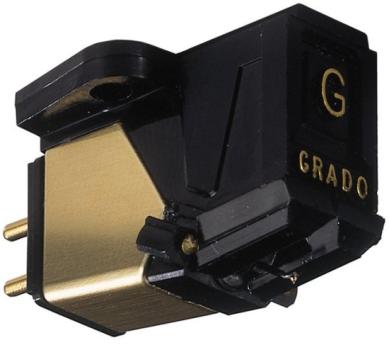MOST AUDIO enthusiasts will have heard of Grado Labs. For nearly 60 years the family-owned company have been making quality, well regarded phono cartridges and headphones. In 1953, New York watchmaker Joseph Grado started making cartridges at his kitchen table. Two years later he opened a factory in Brooklyn on the site of his father’s grocery business, and Grado Laboratories has been there ever since. The factory is modest (some say “dingy”) but profitable and they produce around 60,000 cartridges a year.
For 21 years Grado concentrated on making high quality cartridges and in 1976 produced the Signature range of high-end cartridges, which cost up to $1000. Joseph Grado, who is noted as having invented the stereo moving coil cartridge and was inducted into the Audio Hall Of Fame in 1982, handed over the reins to his nephew John Grado, who now owns and runs the company. John has redesigned the entire Grado range of cartridges, creating a damping system to eliminate resonant distortions in the magnetic and electrical circuits of the cartridge, as well as producing the wood-bodied Reference and Statement series.
In 2008 the entire range from the Prestige Black up to the Statements were upgraded to the “1” series; we’re looking at four cartridges from the budget Prestige1 series, of which the Grado website says: “The newly redesigned Prestige1 series have had their coil design reconfigured and the effective moving mass of their generating system has been reduced by 17%. This decrease in stylus mass allows for enhanced tracking and improved imaging, giving a quicker, more accurate reproduction of the music.”
Being a family owned and operated company is enough to get my bosom heaving with admiration, so I couldn’t wait to have a listen. The Prestige1 range consists of six cartridges, namely the Black1, Green1, Blue1, Red1, Silver1 and, the most expensive Gold1. Up for review are the Black1, the Blue1, the Silver1 and the Gold1. The Prestige range is plastic bodied, the first four in the line-up being silver in colour while the Silver1 and Gold1 are gold. To distinguish between the different models, there are two small dots on the front, either side of the stylus, with the specific colour for the designated model.
Fitting the cartridges is fairly easy, though there are no colour tags on the back to match up the tonearm wires. It’s not rocket science (apologies for the annoying verbal cliche). If you have a Rega turntable or tonearm you’ll need spacers to raise the arm height – your local hi-fi store can supply these. Tracking weight through the models is a consistent 1.5 grams – the carts weigh 6 grams – while output is a high 4-5 Mv and the input load is 47k ohms, so they’ll work with most moving magnet phono stages (strictly speaking these are a moving iron design). The stylus for each model is an elliptical diamond – don’t throw away that long plastic doodad that comes with the packaging as you’ll need it if you ever need to replace the stylus.
The six models are all basically the same design (hence they all look similar) but the quality of materials and tolerancing improves with each model. “The newly designed Black1 and Green1 Models use a three piece OTL (Optimised Transmission Line) cantilever technology, standard oxygen free wire in the coils and Grado’s specifically designed elliptical diamond mounted in a brass bushing. The Green1 is selected from the Black1 production line and meets higher test specifications. Approximately 15% of the production run will meet these standards and become Green1 models.” So says the literature. So the Blue1 and Red1 models use a four piece OTL cantilever technology and the Red is selected from the Blue run with 10% becoming Reds. Lastly, the Silver1 and Gold1 differ from the Blue and Red by using ultra-high purity long crystal (UHPLC) oxygen free copper in the coils. About 5% of Silvers are chosen to become Gold models.
Right, bloody hell, that’s that out of the way, let’s have a listen. Off went my beloved low output moving coil Benz ACE and it was on with the Grado’s. Listening was done with a Rega P3/24 turntable and PSU via a Trichord Dino phono stage. An Arcam amplifier and Spendor speakers did the rest.
The first thing I have to say is that there seems to be a ‘family’ sound (pun not intended) from these four cartridges. Across the board, the midrange is clear and detailed, high frequencies are un-fatiguing and the bass generally goes fairly low and is well defined. Each model had me toe-tapping and sitting back enjoying music without ever doubting the cartridge’s ability to play whatever I put under it. From Count Basie to Rage Against The Machine, Cat Power to Massive Attack, Bob Marley to Radiohead – it all sounded great. I also thought the cartridges all tracked very well.
The Black1 perhaps surprised me the most. I have to admit I was expecting harsh highs and a bloated sounding bass, but I was wrong. The overall presentation was very nice, the midrange being the standout, but the bass – while not terribly low or defined – was easy to follow and highs were rolled off at just the right point to be pleasant and easy on the ear. Playing Count Basie’s beautifully recorded ‘live-in-the-studio’ Basie Jam I did notice the Black1 was a little veiled-sounding, lacking a little in attack, and the soundstage was narrower than I’m used to. I think, though, that was down to coming from my wide-open, airy and detailed Benz MC, because once I became accustomed to the change I soon forgot this and was able to enjoy the entire record. Piano was reproduced well, with both high and low notes easy to distinguish under the bass and drums. Cat Power’s Jukebox was a again, a little closed-in sounding but the track ‘I Believe In You’ had a big drum sound with realistic crashing cymbals. Piano notes decayed nicely and Chan Marshall’s vocals were crisp and clear albeit with some exaggerated sibilance. Rage Against The Machine’s first album sounded great, lacking some visceral slam but being otherwise un-fatiguing and easy to listen to. Cymbal crashes and taps were convincing and room-filling.
The Black1 had some hours on it (as Ashley has already reviewed it) but straight out of the box (my fellow audio-enthusiast, James, commented that it looked like I had a stack of spark plug boxes on my shelf) the Blue1 sounded better than the Black1 – subtly better, but I believe worthy of the price difference. The sound was more open and lively, bass lines seemed easier to follow and there was slightly more detail. Radiohead’s ‘Reckoner’ from In Rainbows sounded lush with a fairly wide soundstage, plenty of detail and a sweet midrange that commanded my attention; Thom Yorke’s vocal floated above the music with a silky quality that was very easy to listen to, higher notes not sounding harsh at all. The Blue1 showed off the fabulous Sly’n’Robbie rhythm section on Grace Jones’ Nightclubbing LP fairly well. It was a tad restrained, with the bass not rattling the cabinet behind me like I’m used to – but you could still get up and shake your butt if that’s your thing. Rage Against The Machine still sounded a bit safe, not giving me shivers and rattling the floorboards (shiver me timbers?) but the album was still enjoyable, lacking the harsh digital glare of my CD version. Overall the Blue1 was reasonably fast, punchy and involving, if a little bit restrained with some recordings; jazz sounded great, rock was more “relaxed”. But there’s very little to fault for the money.
Moving to the Silver1 was another clear step up in sound quality. Again, straight out of the box, it was lively, engaging and more open. I thought pace, rhythm and timing (PRAT) were excellent and cymbals and notes decayed realistically. On the Grace Jones LP drums and percussion were more prominent. The soundstage was deep, extending from well behind the speakers and into the room. There was more “air” around the Basie Jam personnel and it was easy to pick out where everyone was standing/sitting. The soundstage, while still not as wide as I like, was more three dimensional than with the previous cartridges and organ and guitar swirled and stabbed, respectively, out into the room. On the RATM record the guitar was blistering and drums had real slam and weight; instead of just hearing cymbals crash, I could hear the sticks hitting them. And I could almost see Zack De La Rocha roaring his lungs out in front of me. Great stuff. The vocal on Jukebox was equally powerful, with much less sibilance than previously. The sound was big and bold and I got a sense of the recording environment and the positioning of the performers within it.
At $299, the Gold1 is the most expensive in the Prestige1 range and is made of the highest quality parts. So it should sound the best, right? Let’s have a listen.
Well…. this is a damn fine sounding cartridge. It has a big vibrant sound that is overall more cohesive and tonally accurate than the previous models. It just has that extra bit of “oomph” that gets the room – and the listener – excited. That familiar midrange is sweet and detailed and there’s a better sense of depth within the soundstage. Bass, too, seems lowest of all and I could pick out and follow bass lines with ease. All my test records just sounded more “right”. Count Basie’s piano sounded beautiful, notes decaying into the distance, the rest of the ensemble fitting together like a jigsaw puzzle. I could hear the subtle nuances in Cat Power’s vocals and could really get a feeling of being in the studio, as with In Rainbows, where the sound projected out into the room like never before. With RATM the drums had a solid slam that thudded nicely into the floor. The sound was so powerful and the guitar so scorching (in a good way) that it raised the back hair, got the adrenalin pumping and the head nodding vigorously. Image separation was also very good. From the LP Nightclubbing, the song “Pull Up To My Bumper” stopped me in my tracks – it sounded gorgeous. All that lovely percussion, the guitars and synths – there was a party bursting out of my speakers and Grace Jones sounded just like the Jamaican Goddess that she is. This $300 cartridge is a real stunner; big, bold and powerful, I love it. In fact, I want one.
It is worth mentioning that, on my Rega, these cartridges caused some slight humming, heard from my speakers. With the tonearm resting a faint hum could be heard and by the time the needle was in the run-out grooves of a record the hum was louder. At no time could I hear any hum interfering with the music (very important, this). The infamous “Grado hum” (Google it and you’ll find much discussion on audio forums) seems to be a problem common with, but not exclusive to, Rega turntables and may be down to the unshielded Grados picking up electro-magnetic fields emanating from the plinth-mounted AC motor. So perhaps bear in mind your turntable’s design/motor position when considering Grado cartridges, but also know that it may be system dependent. I know someone who ran a Rega P3-24 with a Grado Gold and could only hear a slight hum at the run-in grooves, if he listened for it. The rest of his set-up is entirely different from my own.
Personally, knowing about the potential hum problem and owning a Rega, I would still own and enjoy a Grado. They perform so well musically that I could easily overlook any hum.
Conclusion
So we have a “family sound”. Excellent, sweet midrange, easy-on-the-ear highs and enough detail to keep things interesting and I would expect the sound to improve further after around 40-50 hours of use. I found the cartridges tracked very well and were quite forgiving of surface noise. The Black1 is a great performer which I reckon puts most budget CD players to shame. The Blue1 is a worthy step-up, offering a bit more of everything without stressing the wallet (or the spouse). The Silver1 and Gold1 cartridges offer a look into a more high-end sound, being big and bold, lively and detailed with the Gold1 being my definite favourite. The Grado Prestige1 range are highly capable, musical and thoroughly enjoyable. Whatever your budget, there’s a cartridge to suit and I seriously doubt you’d be disappointed. A.W. BAKER

Four Budget Cartridges From Grado: Prestige Black1 ($163), Prestige Blue1 ($194), Prestige Silver1 ($265), Prestige Gold1 ($299) REVIEW
3 Comments
Leave a Reply
Latest from Recordings

From The Archives: Pacific voyager Mike Cooper
Twenty years ago, GARY STEEL interviewed fascinating Rome-based UK-born folk experimentalist Mike Cooper on one of his Pacific journeys. Here's that story followed by

World’s Worst Records: Damon Albarn’s Everyday Robots
MATT KELLY is surprised and shocked to find that without the collaborations that are his stock in trade Damon Albarn has a yawningly empty

NZ rock still… rocks! We Search For Yeti!
They probably won’t be performing at Spark Arena anytime soon, but GARY STEEL reckons Wellington-based independent rockers Search For Yeti are well worth a

World’s Worst Records – David Hasselhoff’s Looking For Freedom
In Part 3 of a survey of the complete musical works of Sir David Michael Hasselhoff, MATT KELLY dissects the risible Euro-'80s muck that

From The Archives: Sly Dunbar talks
That time GARY STEEL chatted with drummer Sly Dunbar of the famed Jamaican rhythm section, Sly & Robbie. First, the story. After, the unexpurgated










I liked my Grado Gold so much I felt I had to keep it even after a significant upgrade. Bang on the nose with this review from my experience A W Baker! SPOT ON!
Excellent bit of work Andrew and a mammoth task to undertake reviewing a whole range! I’m looking forward to more of your of your enjoyable work. Those Grado carts are great value considering their performance.
I got rid of the hum on my direct drive setup/Grado Gold setup by connecting a fine wire from one cartridge retaining nut, wrapping it around the metal shield case of the cartridge and wrapping it around the ground terminals on the cartridge. A bit heath robinson but it works.